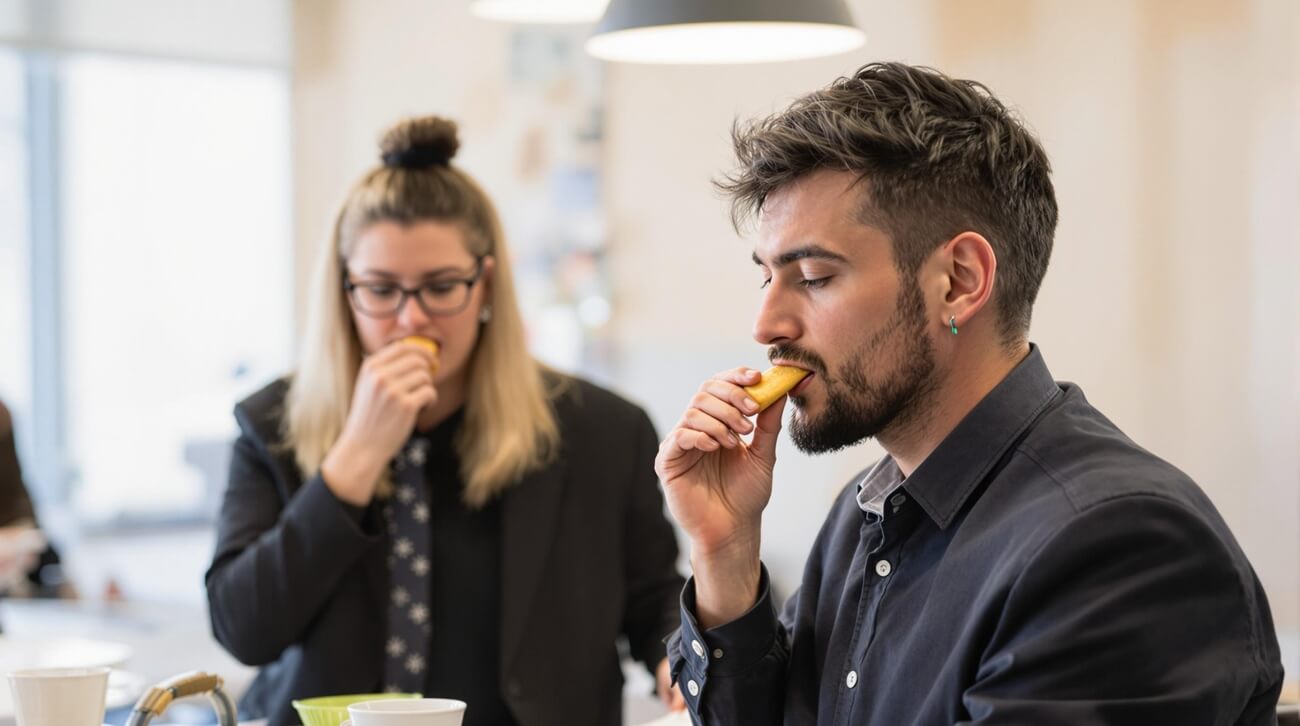順序口味測試市場研究

In the intricate dance of product development, how do businesses ensure that their offering stands out and is preferred by consumers? That’s the role of sequential taste testing market research.
This unique methodology allows businesses to gauge the preference and acceptability of multiple products by presenting them to consumers in a specific order. Unlike traditional taste tests, where products are evaluated in isolation, sequential testing offers insights into how one product’s perception can influence subsequent ones’ perception. With rising competition and evolving consumer preferences, sequential taste-testing market research has emerged as a valuable tool in the arsenal of brands aiming to lead in the current flavor wars.
What Is Sequential Taste Testing Market Research?

Sequential taste testing market research is a specialized methodology employed to evaluate consumer preferences and perceptions about multiple products by presenting them in a particular sequence. Unlike monadic testing, where products are evaluated independently, sequential testing captures the dynamic of tasting products one after another, allowing researchers to analyze how the perception of an earlier sample can influence the subsequent ones.
Importance of Sequential Taste Testing Market Research
In the ever-evolving landscape of consumer preferences, businesses must be aware of how consumers perceive their products, especially about one another. This is where market research comes in. Particularly, it provides:
- Richer Insights: Traditional taste tests often evaluate products in isolation, potentially missing out on how a product’s perception changes when tasted after another. Sequential taste testing market research captures these dynamic shifts, offering deeper, more comprehensive insights.
- Simulating Real-World Scenarios: Consumers often consume products in sequences, whether it’s a three-course meal at a restaurant or a lineup of snacks during a movie night. This method mirrors real-life consumption patterns, making the insights more relevant and actionable.
- Identifying Carryover Effects: One of the standout features of sequential taste testing market research is its ability to detect and measure carryover effects. Understanding how the flavor or aftertaste of one product affects the perception of the next can be vital for product development and marketing.
- Mitigating Palate Fatigue: By studying how consumers react to tasting products in succession, businesses can identify palate fatigue and strategize on product lineup, order, or even flavor intensity to ensure consistent enjoyment.
- Optimizing Product Lineups: For brands offering a range of similar products, sequential testing can help determine the optimal order of presentation or consumption to maximize overall satisfaction.
Practical Applications and Real-world Examples of Sequential Taste Testing Market Research

Sequential taste testing market research is more than just a theoretical methodology. It provides valuable insights to numerous brands, reshaping their products and marketing strategies. Here are some practical applications and real-world examples showcasing its importance:
- Wine Tastings: Wineries often conduct market research when curating the order of wines for tastings. Understanding how the flavor profile of a lighter wine can influence the perception of a subsequent robust wine can be crucial for creating the perfect tasting experience for consumers.
- Fast Food Restaurants: Some fast-food chains employ sequential testing to design combo meals. How does the taste of a burger influence the palate when followed by a specific drink or side? This research aids in optimizing combo offerings for maximum satisfaction.
- Chocolatiers: Premium chocolate brands have employed sequential taste testing market research when launching a new series of chocolates, determining the ideal order to enhance the tasting experience and prevent flavor clashes.
- Cheese Producers: In curated cheese tasting events or when packaging multiple cheeses, sequential testing informs producers about the order that maximizes the individual cheeses’ appeal.
企業的機會
Businesses constantly seek new ways to gain a competitive edge in a saturated market. One innovative and highly effective method is using sequential taste testing market research. This research methodology offers multiple opportunities for businesses to enhance their products and market positioning:
- 優化行銷策略: Market research insights can inform marketing campaigns. If a product is found to be an ideal palate cleanser or a perfect follow-up to another popular product, this can be highlighted in marketing messages.
- Diversified Product Lines: Understanding sequential tastes can inspire the creation of complementary products. If a beverage leaves a lingering spicy note, a subsequent snack product might be developed to harmonize with that particular aftertaste.
- Tailored Product Bundling: For businesses that offer multiple products, sequential taste testing market research can help in bundling products that enhance one another’s flavors, leading to higher sales and consumer appreciation.
- 教育措施: Brands can educate consumers on the ideal sequence of product consumption, adding an experiential layer to their offerings. This provides value and positions the brand as a knowledgeable industry leader.
- 持續改進的回饋循環: Regularly conducted sequential tests can be a feedback mechanism. As tastes evolve and new products are introduced, these tests ensure businesses remain in sync with consumer preferences.
- 價格優化: If a product is perceived as more premium or of higher quality when tasted after another product, businesses might have an opportunity to adjust pricing strategies to reflect this perceived value.
Sequential Taste Testing Market Research: Challenges and Concerns

While sequential taste testing market research offers valuable insights and numerous opportunities for businesses, it is not without its challenges and concerns. As businesses embark on this research journey, they need to be aware of and prepared for the following potential hurdles:
- 分析的複雜性: The sequential nature of the tests means data analysis can be more intricate than traditional testing. This requires specialized expertise to correctly interpret and make actionable recommendations.
- 高成本: Costs can escalate depending on the number of products tested and the sequences analyzed. Sequential testing’s intricacy requires more resources in terms of time and money.
- Ensuring Consistency: It is crucial to achieve consistent conditions across all tests. Even minor variations in temperature, presentation, or setting can impact results, potentially leading to inaccurate conclusions.
- Limitations in Real-world Applicability: Sequential tests can mimic certain real-world scenarios, but they might not capture all consumption contexts. For example, there might be longer gaps between consuming products or other external factors influencing taste perceptions in a real setting.
- Feedback Overload: When multiple products are tasted sequentially, gathering detailed feedback on each can overwhelm participants, leading to more generalized or less accurate feedback.
- 道德考慮: Depending on the products tested, there might be concerns about waste, especially if testers only consume portions. Moreover, it is paramount to ensure that participants are not overconsuming or being exposed to potential allergens or intolerances.
What Makes SIS International a Top Sequential Taste Testing Market Research Company?
SIS國際 stands out as a premier provider of sequential taste testing market research. With over 40 years of expertise, advanced methodologies, and a commitment to actionable insights, SIS helps businesses refine products and succeed in competitive markets.
Expertise in Sequential Testing Methodology
安全資訊系統 specializes in sequential taste testing, a precise methodology that evaluates product variations one at a time to eliminate bias and ensure reliable results. Our expertise in this method ensures businesses gain accurate insights into consumer preferences.
先進的測試設施
Our state-of-the-art facilities are equipped to handle sequential taste testing with precision. Controlled environments and advanced sensory analysis tools ensure that every product evaluation is conducted optimally, yielding high-quality feedback.
造訪不同的消費者小組
New York’s rich diversity allows SIS to recruit a wide range of participants for sequential taste testing. Gathering feedback from various demographics, we provide insights that reflect a broad spectrum of consumer tastes, helping businesses make informed product decisions.
Tailored Solutions for All Industries
From food and beverages to personal care products, SIS International customizes sequential taste testing to fit each client’s unique needs. Whether comparing subtle flavor variations or testing different formulations, we deliver insights that align with business goals.
Over Four Decades of Market Research Excellence
With over 40 years of experience, SIS International has built a reputation for delivering accurate and actionable market research. Our expertise ensures businesses trust us to provide valuable data to guide product development and marketing strategies.
Affordable Services with Maximum Value
安全資訊系統 International is committed to offering high-quality research solutions at competitive rates. Our sequential taste testing services provide exceptional value, making them accessible to businesses of all sizes, from startups to established brands.
Focus on Consumer-Centric Insights
Sequential taste testing at SIS is designed to prioritize consumer preferences. Our in-depth approach uncovers subtle differences in product attributes, helping businesses understand how their products are perceived and how they compare to competitors.
Fast Turnaround for Timely Decisions
In fast-paced industries, timely insights are crucial. SIS’s efficient processes ensure that businesses receive actionable results quickly, enabling them to adapt and stay ahead of market trends.
對客戶成功的承諾
SIS International takes a client-centered approach, working closely with businesses to understand their goals and challenges. Our team of experts provides personalized guidance throughout the research process, ensuring that every project delivers meaningful results.
Strategic Advantage of Sequential Testing
Sequential taste testing gives businesses a strategic edge by isolating variables and minimizing bias. SIS International’s mastery of this method enables brands to confidently make data-driven decisions, ensuring their products meet consumer expectations and stand out in the market.
我們在紐約的工廠位置
11 E 22nd Street, Floor 2, 紐約, NY 10010 電話:+1(212) 505-6805
關於 SIS 國際
SIS國際 提供定量、定性和策略研究。我們為決策提供數據、工具、策略、報告和見解。我們也進行訪談、調查、焦點小組和其他市場研究方法和途徑。 聯絡我們 為您的下一個市場研究項目。


